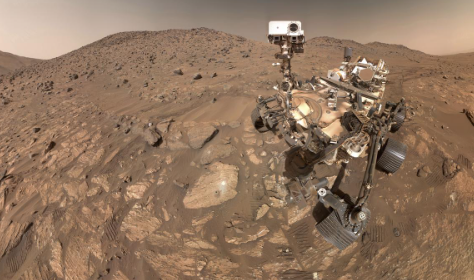NASA’s Perseverance Rover Begins Climb to Jezero Crater Rim
NASA’s Perseverance rover began an important new phase of its mission on Mars by starting its climb to the top of Jezero Crater, on August 27, 2024. After spending over three years exploring the crater’s floor, the rover is now on a journey to reach the crater’s rim. This mission is particularly exciting because the rock samples it collects could help scientists learn more about Mars’ climate history and whether life ever existed on the planet.
Mission Overview
Perseverance landed on Mars in 2021 and has been busy since then, gathering 22 rock core samples from the base of Jezero Crater. This crater was once filled with water, making it an ideal place to look for signs of ancient life. The rover’s current mission is to climb 1,000 feet (305 meters) to the rim of the crater, where it will collect and analyze more rock samples.
Scientific Goals
The rocks that Perseverance is collecting may give scientists valuable clues about what Mars was like billions of years ago. By studying these rocks, researchers hope to understand how Mars’ environment has changed over time and whether it could have supported life in the past.
Bringing the Samples Back to Earth
NASA is working on ways to bring these rock samples back to Earth. Studying them in detail here could provide important information about how planets like Mars are formed and how they evolve over time.
Challenges of the Climb
The journey to the top of the crater won’t be easy. The terrain is rough, with rocky landscapes and steep slopes that can reach up to 23 degrees. Despite these challenges, Perseverance has already traveled about 29 kilometers on Mars, proving that it is tough and capable of handling the difficult conditions.
The rocks at the edge of the crater may have formed near ancient hydrothermal vents, which are areas where hot water once flowed. On Earth, places like these, such as those in Yellowstone National Park, are known to support a variety of life forms. If similar conditions existed on Mars, studying these rocks could help scientists learn whether life might have once thrived there. This makes Perseverance’s mission a key part of understanding Mars and its potential to host life.
What is Jezero Crater?
Jezero Crater is a spot on Mars that is about 45 km wide. Scientists think that over 3.5 billion years ago, it might have been a lake. The crater has a delta made from sediment, suggesting there could have been tiny life forms in the past. NASA’s Perseverance rover landed there in February 2021 to look for signs of past life. The crater has different types of rocks that could help scientists understand Mars’ climate history. The crater is named after a town in Bosnia and Herzegovina, following the tradition of naming Martian features after places on Earth.
Facts About Perseverance Rover
- Perseverance rover was launched on July 30, 2020, and landed on Mars on February 18, 2021.
- The rover has ten scientific instruments, including a small helicopter named Ingenuity.
- Ingenuity made history by performing the first powered flight on Mars.
- Perseverance’s main job is to search for signs of ancient life on Mars and collect samples that can be brought back to Earth in the future.
- It can study rocks and soil, make oxygen from the Martian atmosphere, and move at a maximum speed of 0.1 miles per hour on Mars.
Month: Current Affairs - August, 2024
Category: Science & Technology Current Affairs


